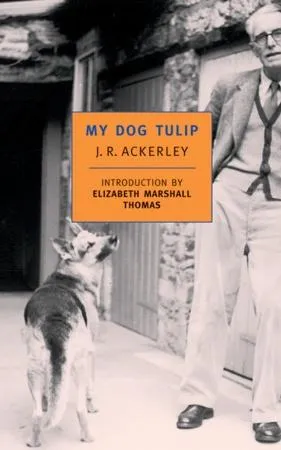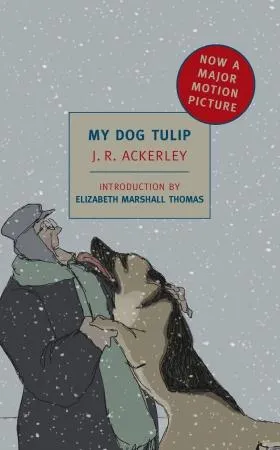Owning an Alsatian dog, also known as a German Shepherd, brings immense joy but also unique challenges in daily care. J.R. Ackerley’s memoir My Dog Tulip (1956), based on his real-life experiences with his beloved Alsatian Queenie (renamed Tulip for the book), offers timeless insights into Alsatian dog care. Spanning 15 happy years together, Ackerley’s account highlights the deep bond between owner and dog, while addressing practical issues like behavior, hygiene, breeding, and aging. For new and experienced Alsatian owners, these observations provide valuable guidance rooted in real-world devotion.
 Cover of My Dog Tulip by J.R. Ackerley, NYRB Classics edition
Cover of My Dog Tulip by J.R. Ackerley, NYRB Classics edition
Understanding Your Alsatian’s Protective Behavior and Vet Challenges
Alsatians are fiercely loyal, often displaying intense protectiveness toward their owners. Ackerley describes Tulip’s unyielding devotion, which made veterinary visits a nightmare—she’d become agitated around strangers, especially when they approached her human. This jealousy and need to guard stemmed from her love, complicating routine check-ups and treatments.
A pivotal moment came when a vet astutely diagnosed the issue: “Tulip’s a good girl… You’re the trouble. Well, she’s in love with you, that’s obvious. And so life’s full of worries for her. She has to protect you… she’s afraid that they may take hold of her and deprive her of her freedom to guard you.” This explanation underscores a key aspect of Alsatian dog care: dogs mirror our emotions and prioritize our safety. Without the owner present, Tulip was calm and handleable, proving her behavior was owner-centric.
For Alsatian owners, this means preparing for vet appointments by using calming aids like pheromone collars or practicing desensitization training early. According to the American Kennel Club (AKC), consistent socialization from puppyhood helps mitigate such protective instincts, ensuring smoother healthcare routines. Ackerley’s experience reminds us to empathize with our dogs’ perspective, fostering trust that benefits long-term care.
Managing Bathroom Habits: Liquids and Solids in Alsatian Care
One of the most candid chapters, “Liquids and Solids,” delves into Tulip’s elimination habits—a reality every dog owner faces. Ackerley details her defecation posture vividly: “Her long tail, usually carried aloft in a curve, stretches rigidly out parallel with the ground; her ears lie back, her head cranes forward, and a mild, meditative look settles on her face.” This level of observation highlights the importance of monitoring your Alsatian’s bathroom routines for health clues.
In mid-20th-century Britain, fouling sidewalks was common, with Ackerley incredulously pondering expectations to prevent it—pre-dating modern bagging norms. Today, responsible Alsatian dog care demands immediate cleanup using biodegradable bags, preventing environmental harm and fines. Ackerley also shares a poignant incident: Tulip signaling urgently to go out while staying with friends, only for him to miss the cues, resulting in carpet accidents and her banishment. This emphasizes reading subtle body language, like whining or circling, to avoid mishaps.
Diet plays a crucial role; high-quality kibble formulated for large breeds like Alsatians supports firm stools. Vets recommend portion control to manage both liquids (urine marking territory) and solids, reducing issues like diarrhea from overfeeding. Regular deworming and probiotics, as advised by organizations like the World Small Animal Veterinary Association (WSAVA), ensure digestive health.
 NYRB Classics edition cover of My Dog Tulip, featuring the dog's story
NYRB Classics edition cover of My Dog Tulip, featuring the dog's story
Breeding Considerations for Pedigree Alsatians
Ackerley devoted significant effort to breeding Tulip with a suitable Alsatian stud, driven by her beauty: “so beautiful a creature as Tulip should certainly have children as pretty as herself.” This section, nearly a third of the book, covers the intricacies—from locating breeders to anatomical queries like “where exactly is the vagina?”—revealing the hands-on realities of responsible breeding.
For Alsatian owners contemplating litters, health screenings are paramount. Hip dysplasia, common in the breed, requires OFA (Orthopedic Foundation for Animals) certifications for both parents. Ackerley’s trials illustrate timing challenges, heat cycles, and post-mating care, stressing spaying/neutering unless breeding ethically. The AKC guidelines echo this: avoid profit-driven mating; prioritize temperament and genetics.
Caring for Your Senior Alsatian: The Turn of the Screw
As Tulip aged to 16.5 years, Ackerley poignantly captured her fading fertility and vitality: “It is spring, it is winter, it is summer…” He provided everything possible but couldn’t halt time, mirroring the emotional toll on owners. Senior Alsatian dog care involves joint supplements like glucosamine, softer bedding for arthritis, and frequent vet checks for age-related issues like hypothyroidism.
Ackerley’s wood walks, where he meticulously removed bottle shards to protect her paws, symbolize proactive hazard-proofing. Echoing this, the ASPCA advises securing yards and using booties for urban strolls. His devotion—rooted in mutual love—offers a model for end-of-life care, including humane euthanasia discussions.
In My Dog Tulip, Ackerley’s life intertwined with Tulip’s, shaping his happiest years despite trials. Alsatian owners can draw from these lessons: prioritize empathy, hygiene, informed breeding, and compassionate senior support. Consult your vet for tailored advice, and explore more on German Shepherd care resources.
References
- Ackerley, J.R. My Dog Tulip. New York Review Books Classics, 2006 (original 1956).
- Acocella, Joan. “Dog Days: J.R. Ackerley and his dog.” The New Yorker, February 7, 2011. Link.
- American Kennel Club (AKC). German Shepherd breed standards.
- World Small Animal Veterinary Association (WSAVA). Nutritional guidelines for dogs.
For more Alsatian dog care tips and pet health advice, check our guides on German Shepherd training and nutrition!
